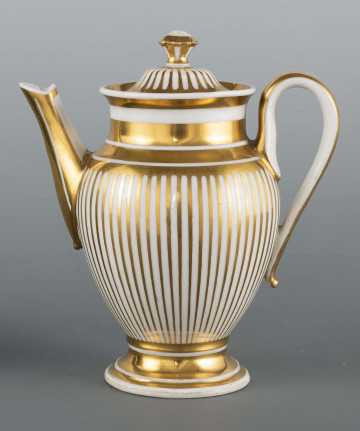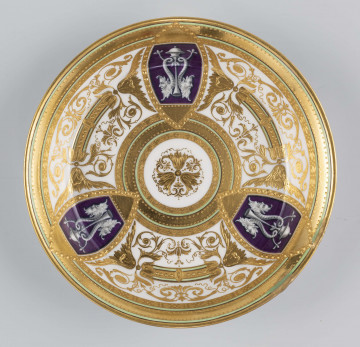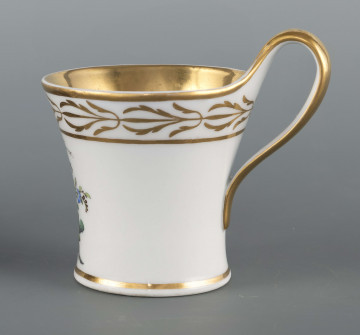
Coffee pot
1834
National Museum in Lublin
Part of the collection: Goldsmithery
The tray originally served as a stand for small toiletries, so the whole decoration concentrates around the edge. It is dominated by an ornament popular in the art of the second quarter of the 18th century, the so-called rocaille – a fanciful form, which used to be called a cock's comb in Poland. Among these decorations, an attentive viewer will notice marks (punches), which contain information about the creator of the object, the place and time of its creation, and even its later history. There are three marks – or stamps – put here. The first contains the letters ICS, which mean Johann Christoph Stenglin, a German goldsmith active in Augsburg between 1737 and 1775. The second depicts a pinecone, namely a somewhat simplified sign of this city, and the letter F added below it determines the time of creation between 1743 and 1745. Augsburg was known for its cloth production in the Middle Ages. In the 15th century, however, the local bankers and merchants acquired shares in the silver mines, after which the city gradually grew to become the leading goldsmithing centre in Europe. Gold and silver in their pure form are too soft to make products from, so they were mixed with other metals to achieve suitable hardness. It created opportunities for fraud, which the city authorities prevented by introducing markings to guarantee that the proportions of alloy used were under local law. On the reverse of the tray, one can see a trace of the assayer's activity, the so-called quavering stroke. It is a zigzag line a few centimetres long left after a small metal sample was cut with a chisel to determine the amount of silver in the alloy. Among the tray ornaments one can find one more stamp depicting an owl's head, which appeared almost two hundred years later. Used in Poland after 1920, it proves that the owner of that time got into financial trouble, and this luxurious object was pawned. After another half-century, it found its final place in the museum's collection.
Barbara Czajkowska
Author / creator
Dimensions
cały obiekt: height: 20,3 cm, width: 28 cm
Object type
goldsmith's art
Technique
gilding
Material
silver
Creation time / dating
Creation / finding place
Owner
The National Museum in Lublin
Identification number
Location / status

1834
National Museum in Lublin

1800
National Museum in Lublin

1810 — 1820
National Museum in Lublin
DISCOVER this TOPIC
Museum of King Jan III's Palace at Wilanów
DISCOVER this PATH
Educational path